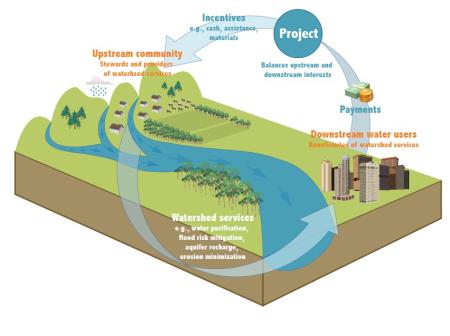
Resource description:
Payment for Ecosystem Services (PES) programmes have been increasingly established across the globe in the last few years. PES is a type of market-based instrument that is increasingly used to finance nature conservation. PES programmes allow for the translation of the ecosystem services (ES) that ecosystems provide for free into financial incentives for their conservation, targeted at the local actors who own or manage the natural resources. Under OPERAs the aim is to explore the potential of PES to protect and improve our Natural Capital. In order to do so, the policy demand, the information needs, the strong and weak points, and the potential benefits and risks of PES are being analysed.
Author/Contact:
Institute for European Environmental Policy (IEEP)
Requirements:
- Lessons learned from the application of PES over the past few years highlight the importance of the initial planning stage to ensure schemes are effective and suitable for local conditions.
- Participation of stakeholders is key to the success of PES.
- The payment is usually based on the opportunity costs of conservation and not on monetary evaluation of ES. It often requires a long process of negotiation, where the role of intermediaries is key.
Advantages:
- PES is highly flexible and there are numerous ways to structure schemes based on the specific context of its application including, for example, the focal ES and scale of application.
- PES schemes offer opportunities to create or support employment related to the delivery of ecosystem services.
- PES can highlight the value of ecosystem services, thereby modifying and potentially reversing incentives for resource users to over-exploit or convert them.
Constraints:
- Application of PES is not appropriate everywhere. Implementation where resource tenure or use rights are not well defined or enforced can be particularly challenging.
- Although PES is straightforward in theory, in practice there are a significant number of barriers to overcome in developing workable PES programmes, including: informational, technical, spatial, temporal, financial, institutional, legal, cultural, and equ
- In general, PES should not be regarded as a panacea or blueprint for environmental conservation, but only as one of the instruments that can contribute to nature conservation, under certain specific circumstances - a complement, and not a substitute for r
Additional information:
ten Brink P., Bassi S., Bishop J., Harvey C.A., Karousakis K., Markandya A., Nunes P.A.L.D., McConville A.J., Ring I., Ruhweza A., Sukhdev P., Vakrou A., van der Esch S., Verma M., and Wertz-Kanounnikoff S. (2011). Rewarding Benefits through Payments and Markets. In TEEB (2011) The Economics of Ecosystems and Biodiversity (TEEB) in National and International Policy Making An output of TEEB, edited by Patrick ten Brink, IEEP. Earthscan, London.
Muradian R., Corbera E., Pascual U., Kosoy N. and May P. (2010). 'Reconciling theory and practice: An alternative conceptual framework for understanding payments for environmental services'. Ecological Economics 69: 1202-1208.
Licence:
- Free, no licence
Development stage:
- Full, working product